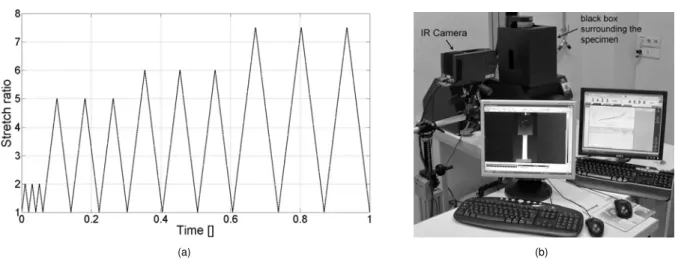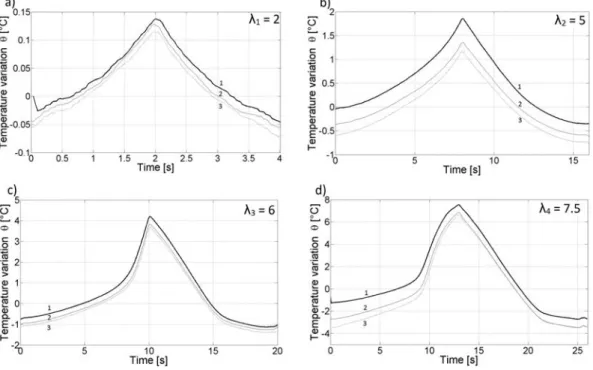HAL Id: hal-01136523
https://hal.archives-ouvertes.fr/hal-01136523
Submitted on 7 May 2020
HAL is a multi-disciplinary open access
archive for the deposit and dissemination of
sci-entific research documents, whether they are
pub-lished or not. The documents may come from
teaching and research institutions in France or
abroad, or from public or private research centers.
L’archive ouverte pluridisciplinaire HAL, est
destinée au dépôt et à la diffusion de documents
scientifiques de niveau recherche, publiés ou non,
émanant des établissements d’enseignement et de
recherche français ou étrangers, des laboratoires
publics ou privés.
Distributed under a Creative Commons Attribution| 4.0 International License
Thermal and calorimetric evolutions of natural rubbers
under cyclic loadings
Jose Ricardo Samaca Martinez, Jean-Benoit Le Cam, Xavier Balandraud,
Evelyne Toussaint, Julien Caillard
To cite this version:
Jose Ricardo Samaca Martinez, Jean-Benoit Le Cam, Xavier Balandraud, Evelyne Toussaint, Julien
Caillard. Thermal and calorimetric evolutions of natural rubbers under cyclic loadings.
Photome-chanics, May 2013, Montpellier, France. �hal-01136523�
THERMAL AND CALORIMETRIC EVOLUTIONS OF NATURAL RUBBERS UNDER CYCLIC LOADINGS
J. R. Samaca Martinez?,†,∗, J.-B. Le Cam‡, X. Balandraud?,†, E. Toussaint?,†, J. Caillard∗
?CLERMONT UNIVERSITÉ, Université Blaise Pascal, Institut Français de Mécanique Avancée
Institut Pascal, BP 10448, 63000 Clermont-Ferrand, France
†CNRS, UMR 6602, Université Blaise Pascal
Institut Pascal, 63171 Aubière, France
‡UNIVERSITÉ DE RENNES 1, LARMAUR ERL CNRS 6274
Campus de Beaulieu, 35042 Rennes, France
∗Manufacture Française de Pneumatiques MICHELIN
CERL Ladoux, 63040 Clermont-Ferrand, France
ricardo.samaca@ifma.fr, jean-benoit.lecam@univ-rennes1.fr, xavier.balandraud@ifma.fr, evelyne.toussaint@univ-bpclermont.fr, julien.caillard@fr.michelin.com
ABSTRACT: The aim of this study is to characterize and to interpret both the thermal and the calorimetric responses of unfilled natural rubber subjected to a cyclic loading test. For this purpose temperature variations of specimens are measured by infrared thermography during the test at ambient temperature. Then, the heat sources produced or absorbed by the material due to deformation processes are deduced from the temperature variations by using the heat diffusion equation. Different results are obtained. First, the heat source due to thermoelastic (entropic) coupling increases with the stretch ratio at constant stretch rate. Second, under the assumption that the mean of thermo-mechanical couplings vanishes on one cycle, no mechanical dissipation (intrinsic dissipation) is detected during the material deformation even if a hysteresis loop is observed in terms of the mechanical response. Finally, the crystallization of the polymer chains under tension leads to a temperature increase of the order of several degrees Celsius.
1. INTRODUCTION
It is well-known that natural rubber (NR) has excellent mechanical properties (i.e. high elasticity, low damping, high elon-gation at failure, etc) which are widely used in many fields, such as mechanical, automotive and aerospace engineering. However, this type of material is subjected to numerous physical mechanisms during the deformation process which are still not clearly understood and feed the scientific debate: Mullins effect [1, 2], cavitation [3, 4], strain induced crystalliza-tion [5, 6, 7, 8] and energetic and entropic effects on the thermomechanical response. From an experimental point of view several techniques have been used to study such phenomena, X-ray diffraction, X-ray microtomography, dilatometry, among others. Nevertheless, no temperature variation or heat production can be detected with the abovementioned tech-niques. Full-field measurement techniques and specially infrared (IR) thermography are appropriate techniques to detect the heat sources produced by the material itself during the deformation process from measured temperature variations. The present paper aims at analyzing the temperature variations as well as heat sources produced in order to characterize the thermomechanical behavior of natural rubber under homogeneous cyclic uniaxial tensile test, at ambient temperature. The first section describes the experimental setup, i.e. the material, the specimen geometry, the loading conditions, temperature field measurement and the post-processing. The second section presents both the thermal and calorimetric results obtained and a discussion on the deformation processes. Finally, a conclusion recalls the main results of the paper.
2. EXPERIMENTAL SETUP
2.1 Material and specimen geometry
The material considered here is an unfilled natural rubber. It is denoted NR in the following. The compound was cured for 22min at 150◦C. This material was chosen in order to study the thermal and thermomechanical response of the macromolecular network without interaction between the rubber matrix and the fillers. It should be noted that this rubber formulation leads to stress-induced crystallization [7, 9]. In particular, the characteristic stretch ratios at which crystallization and crystallite melting occur are denotedλcandλmand are close to4and3, respectively.
The specimen geometry has a width of 5mm, a height of 10mmand a thickness of 1.4mm. Its width was chosen to ensure that the strain and stress fields are homogeneous, thus corresponding to a uniaxial tension state.
2.2 Loading conditions
The mechanical loading was applied using a 50N INSTRON 5543 testing machine under imposed displacement, the test corresponds to four sets of three cycles, for four increasing maximum stretch ratios:λ1= 2,λ2= 5,λ3= 6andλ4= 7.5
(see Figure 1(a)).λ1was chosen inferior toλc,λ2was close toλcandλ3andλ4are superior toλc(λ4is close to the failure
2.3 Temperature field measurement and post-processing
Temperature measurements were performed using a Cedip Jade III-MWIR infrared camera, which features a local plane array of320 × 240 pixelsand detectors with a wavelength range of3.5 − 5 µm. The integration time is1500 µsand the acquisition frequency fais147 Hz. The thermal resolution, namely the noise-equivalent temperature difference, is equal to
20 mKfor a temperature range of5 − 40◦C. The calibration of the camera detectors was performed using a black body and using a Non-Uniformity Correction (NUC) procedure. During the measurement, the external heat sources were reduced by using a black box surrounding the specimen, featuring a small window for the IR camera to be able to observe the gauge zone of the specimen (see Figure 1(b)). The thermal quantity considered in the present study is the mean temperature variation of a small zone at the centre of the specimen. This quantity is obtained by subtracting the initial temperature from the current one, after applying a suitable movement compensation technique to track this small zone during the test.
(a) (b)
Figure 1 - Mechanical loading conditions and overview of the experimental setup.
The temperature fields that are measured at the flat surface of a specimen by an IR camera are bidimensional. As the tests performed are assumed to be homogeneous in terms of strain and stress and as rubbers have a very low thermal diffusivity (leading to nearly homogeneous temperature fields), a ’0D’ formulation of the heat diffusion equation (1) can be used to calculate the heat sources produced by material itself [10]:
˙θ +θ τ =
s ρ CE,Vk
(1)
Whereρ is the density,CE,Vk is the specific heat at constant strain tensor E and internal variablesVk,τis a time
constant characterizing the heat exchanges between the specimen and its environment andsrepresents the heat sources produced by the material itself. Let us conclude with some considerations on units. The heat sourcesis expressed in W m−3. However, it is generally useful to divide this quantity byρ CE,Vk. The quantitys/ρCE,Vkin equation (1), is expressed
in◦C/s(corresponding to the temperature rate that would be obtained in an adiabatic case).
3. RESULTS
3.1 Thermal response
The thermal response of the specimen was measured during the mechanical test. The aim of such a measurement is to characterize the thermal response of rubber during a classic mechanical test. Figure 2 presents the temperature variation θobtained during the test for each stretch ratio tested, it can be noted that the temperature variations time scale has been initialized at the beginning of each cycle. Figure 2(a), shows the temperature variation during the three cycles atλ1= 2.
During the beginning of the loading phase, the temperature variation first decreases before increasing. This is a well-known phenomenon in rubbery materials [11], which is explained by the competition between the effects of internal energy variation and entropy variation with respect to the strain level. This leads to the occurrence of the so-called thermoelastic inversion, here close toλ = 1.1. At higher strain levels, the temperature variation is governed by entropic coupling, so a temperature increase is then observed. It can be also noted that the temperature variation at the end of the first cycle is inferior to that at the beginning of the cycle. In Figures 2(a),(b),(c)and (d) a shift in the curve position is observed between the cycles. This observation can be explained by considering the heat exchanges with the outside of the specimen (mainly the ambient air), more precisely the non-adiabaticity conditions on the thermal response. Figure 2(c) and (d) show a strong increases in temperature variation if the current stretch ratio during loading exceed the stretch ratio at timet= 7s(whenλ ≈ λc). Two reasons can explain that this phenomenon is due to crystallization. First, crystallization is a strong exothermic
phase. Two factors may explain this phenomenon: either heat exchanges with the outside of the specimen, or a decrease in the crystallization rate, as shown in [12]. Only an analysis based on heat source calculation can provide the explanation. These results show that thermal measurements provide additional information that is not available from the strain-stress relationships. Nevertheless due to the non-adiabaticity conditions, temperature variation is not the most relevant quantity to study the thermomechanical behavior of rubbers. This is why analyzes have been carried out in terms of heat sources. This part of the work will be precisely detailed during the oral presentation, for the four maximum stretch ratios tested.
Figure 2 - Temperature variation for the four stretch ratios tested.
4. CONCLUSION
The thermal and calorimetric responses of unfilled natural rubber have been characterized and interpreted. The thermal response is found to provide additional information on deformation processes, more particularly with respect to strain-induced crystallization. Indeed, a significant temperature increase is observed when strain-strain-induced crystallization occurs, and the temperature evolution shows that the kinetics of crystallization and of crystallite melting are different. First results obtained with quantitative calorimetry provide additional information on physical phenomena involved during deformation of natural rubber.
5. ACKNOWLEDGEMENTS
Authors acknowledge the "Manufacture Française des pneumatiques Michelin" for supporting this study. Authors also thank D. Berghezan, F. Vion-Loisel and E. Munch for the fructuous discussions.
6. REFERENCES
1. Mullins L. (1948). Effect of stretching on the properties of rubber. Rubber Chemistry and Technology, 21:281–300. 2. Chagnon G., Verron E., Gornet L., Marckmann G., and Charrier P. (2004). On the relevance of the Mullins effect as
applied to stress-softening in elastomers. Journal of the Mechanics and Physics of Solids, 52:1627–1650.
3. Stringfellow R. and Abeyaratne R. (1989). Cavitation in an elastomer: Comparison of theory with experiment. Materials Science and Engineering: A, 112:127–131.
4. Le Cam J.-B. and Toussaint E. (2008). Volume variation in stretched natural rubber: competition between cavitation and stress-induced crystallization. Macromolecules, 41:7579–7583.
5. Toki S., Sics I., Ran S., Liu L., Hsiao B.S., Murakami S., Senoo K., and Kohjiya S. (2002). Macromolecules, 35:6578– 6584.
6. Trabelsi S., Albouy P.-A., and Rault J. (2002). Stress-induced crystallization around a crack tip in natural rubber. Macromolecules, 35:10054–10061.
7. Trabelsi S., Albouy P.-A., and Rault J. (2003). Effective local deformation in stretched filled rubber. Macromolecules, 36:9093–9099.
8. Huneau B. (2011). Strain-induced crystallization of natural rubber: a review of x-ray diffraction investigations. Rubber Chemistry and Technology, 84:425–452.
9. Marchal J. (2006). Cristallisation des caoutchoucs chargés et non chargés sous contrainte : Effet sur les chaînes amorphes. PhD thesis, PhD Thesis, Université Paris XI Orsay, France.
10. Chrysochoos A. (1995). Analyse du comportement des matériaux par thermographie infra rouge. In Colloque Pho-tomécanique, volume 95, pages 201–211.
11. Joule J. P. (1857). On some thermodynamic properties of solids. Phil Mag 4th, 14:227.
12. Flory P. J. (1947). Thermodynamics of crystallization in high polymers. i. crystallization induced by stretching. The Journal of Chemical Physics, 15:397–408.

